|
Collecting Seriously Fancy Glass
by Bob Brooke
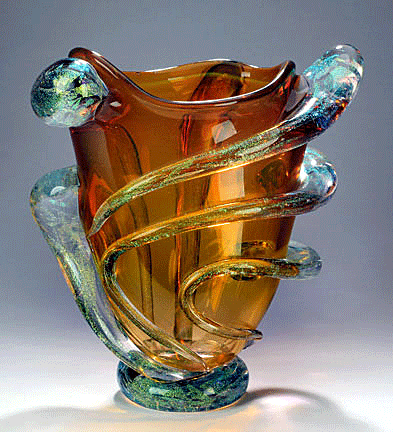 The
last 30 years of the 19th century witnessed several new types of
decorative glass. Referred to as “art glass,” it satisfied the Victorian
desire for highly ornate and colorful decoration. The
last 30 years of the 19th century witnessed several new types of
decorative glass. Referred to as “art glass,” it satisfied the Victorian
desire for highly ornate and colorful decoration.
Art glass was, at least in the Western world, an international style,
with centers in England, Bohemia and other central European areas.
Historians find it difficult to tell
whether it first appeared in Bohemia or England. Both areas, but in
particular England, had a strong influence on its development in
America.
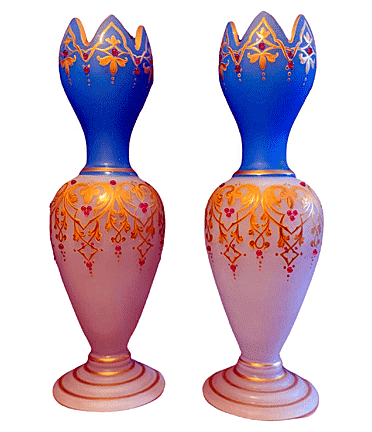 The
first type of art glasses were probably silvered, or mercury, glass,
along with opal-decorated glass. A patent for the first commercially
practical method for producing silvered girl]] granted to Hale Thomson
in London in about In America, William Leighton, an Englishman became
superintendent of the New England Works, was granted a patent on 16
January for silvered-glass door-knobs, which he claimed, superior to
silver articles. The
first type of art glasses were probably silvered, or mercury, glass,
along with opal-decorated glass. A patent for the first commercially
practical method for producing silvered girl]] granted to Hale Thomson
in London in about In America, William Leighton, an Englishman became
superintendent of the New England Works, was granted a patent on 16
January for silvered-glass door-knobs, which he claimed, superior to
silver articles.
Many American glasshouses produced opal-decorated wares, more commonly
known as “milk” glass, from about 1855 onward. English firms such as W.
H. B. & J. Richardson, with their opal-decorated products, had a marked
influence on American wares. For example, William L. Smith and his sons,
Alfred and Harry, emigrated to America and began working for the Boston
Sandwich Glass Company in about 1855. In 1871, William Libbey employed
the Smith brothers to operate the large decorating shop established at
the Mount Washington Glass Works.
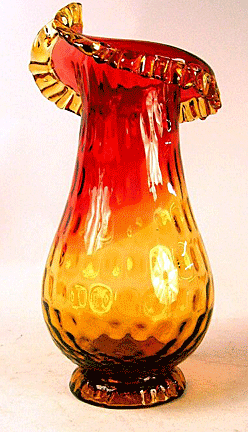 Englishman
Frederick S. Shirley, who possessed a vast knowledge of glassmaking and
was also a acute businessman, became the agent for the Mount Washington
Glass Company in 1874, and under his direction made it into the
“American Headquarters for Art Glass Wares.” Englishman
Frederick S. Shirley, who possessed a vast knowledge of glassmaking and
was also a acute businessman, became the agent for the Mount Washington
Glass Company in 1874, and under his direction made it into the
“American Headquarters for Art Glass Wares.”
The first shaded art glass was Amberina, patented on July 24, 1883, by
Joseph Locke, another Englishman, who had emigrated to work for the New
England Glass Company located in East Cambridge, near Boston,
Massachusetts. This glass shaded gradually from an amber color near the
base to a deep ruby or fuchsia red at the top.
Amberina came in a wide variety of forms. Its success was so great that
Mount Washington Glass copied it, and after being threatened with a
lawsuit by the New England Glass Company, agreed to call its product
“Nose Amber,” although their advertisements frequently used the terms
“Rose Amberina”' and “Amberina.”
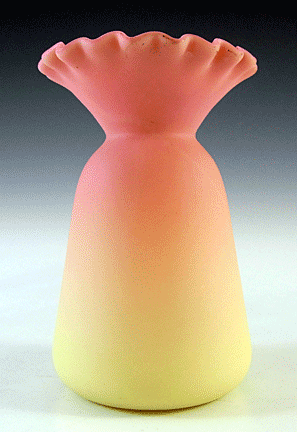 The
development of other shaded art glasswares followed rapidly. On December
15, 1885, Shirley received a patent for Burmese glass, an opaque glass
containing gold and uranium oxides which produced a glass gradually
shading from a delicate pale yellow to a plushy pink color. This glass,
too, caught the public's fancy and was a great commercial success. It
came in about 250 different forms, available in two finished, glossy and
plush, now called “satin glass.” A number of the forms were decorated. The
development of other shaded art glasswares followed rapidly. On December
15, 1885, Shirley received a patent for Burmese glass, an opaque glass
containing gold and uranium oxides which produced a glass gradually
shading from a delicate pale yellow to a plushy pink color. This glass,
too, caught the public's fancy and was a great commercial success. It
came in about 250 different forms, available in two finished, glossy and
plush, now called “satin glass.” A number of the forms were decorated.
To promote his Burmese glass, Shirley sent a tea set decorated with what
he termed the “Queen's Burmese” pattern as a gift to Queen Victoria .She
loved it and ordered more Burmese. In 1886, Mount Washington Glass
licensed Thomas Webb & Sons of Stourbridge, England, to produce this
glass.
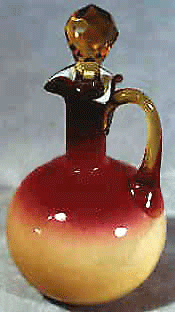 Peach
Blow was another graduated colored glassware produced by Mount
Washington Glass. It shaded from a slightly bluish white to a pink
color, and although very attractive, wasn’t a commercial success.
Nevertheless, the New England Glass Company emulated it in its wild
rose, shaded from white to a deep pink color. Both firms produced these
wares in glossy and plush finishes, and both decorated some of them. Peach
Blow was another graduated colored glassware produced by Mount
Washington Glass. It shaded from a slightly bluish white to a pink
color, and although very attractive, wasn’t a commercial success.
Nevertheless, the New England Glass Company emulated it in its wild
rose, shaded from white to a deep pink color. Both firms produced these
wares in glossy and plush finishes, and both decorated some of them.
Hobbs-Brockunicr & Company, of Wheeling, West Virginia, made their own
version of Peach Blow glass which they called “Coral.” It was a cased,
or plated, glass, consisting of an opaque-white interior covered with a
thin layer of transparent glass shading from a pale yellowish color at
the base to a deep orange-red at the top.
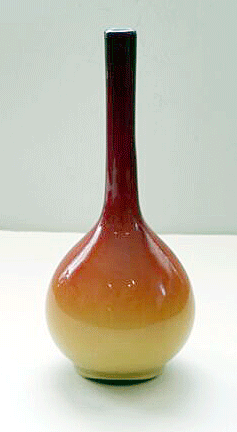 Very
much like Coral, or Wheeling Peach Blow, except in color was New England
Glass Company's Plated Amberina, for which Edward Libbey received a
patent on June 15, 1886. It was actually Amberina encasing an
opaque-white glass, and is almost always pattern-molded. It was
seemingly produced in limited quantities, and is much sought after by
collectors. Very
much like Coral, or Wheeling Peach Blow, except in color was New England
Glass Company's Plated Amberina, for which Edward Libbey received a
patent on June 15, 1886. It was actually Amberina encasing an
opaque-white glass, and is almost always pattern-molded. It was
seemingly produced in limited quantities, and is much sought after by
collectors.
Joseph Locke, of the New England Glass Company, received a patent on
January 18, 1887, for Agate glassware which was simply Wild Rose glass
which had been decorated by brownish and purplish stains, usually
applied in a random splotched pattern. Glassworkers achieved this by
partially or wholly covering an article with a metallic stain or mineral
color and then spattering it with a volatile liquid such as alcohol,
benzene or naphtha. This produced a mottled effect which became
permanent when fired. However, Agata, which was usually found in the
same forms as Wild Rose, wasn’t commercially successful.
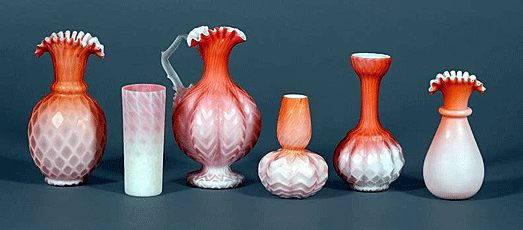
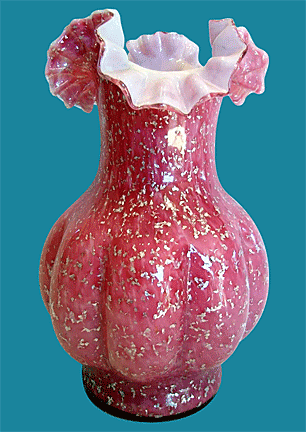 Widely
produced Pearl Satin Ware, or “satin glass,” was one of the most popular
types of art glass. Frederick Shirley received a trade-mark for Pearl
Satin Ware on June 29, 1886. He achieved the satin-like finish by either
exposing the glass to the fumes of hydrofluoric acid, or dipping it in a
bath of this acid, for a few minutes. Mount Washington Glass Company
licensed Thomas Webb & Sons that same year to produce Pearl Satin Ware. Widely
produced Pearl Satin Ware, or “satin glass,” was one of the most popular
types of art glass. Frederick Shirley received a trade-mark for Pearl
Satin Ware on June 29, 1886. He achieved the satin-like finish by either
exposing the glass to the fumes of hydrofluoric acid, or dipping it in a
bath of this acid, for a few minutes. Mount Washington Glass Company
licensed Thomas Webb & Sons that same year to produce Pearl Satin Ware.
In 1883 William Leighton Jr. created a spangled glass, made by picking
up flakes of mica on an initial gather of glass, then covering them over
with a glass of another color.
Two other types of art glass utilizing applied glass for decorative
effects were mechanically threaded glass and “overshot” or “ice” glass.
The Boston & Sandwich Glass Company, established in Sandwich, Cape Cod,
Massachusetts, in 1825, made both types of glasses. Artisans often
engraved these mechanically threaded pieces above the threading with
marshland scenes or foliate forms.
The production of American art glass declined as the 19th century drew
to a close and ceased by 1900.
< Back to Collecting Archives
Next Article > |
